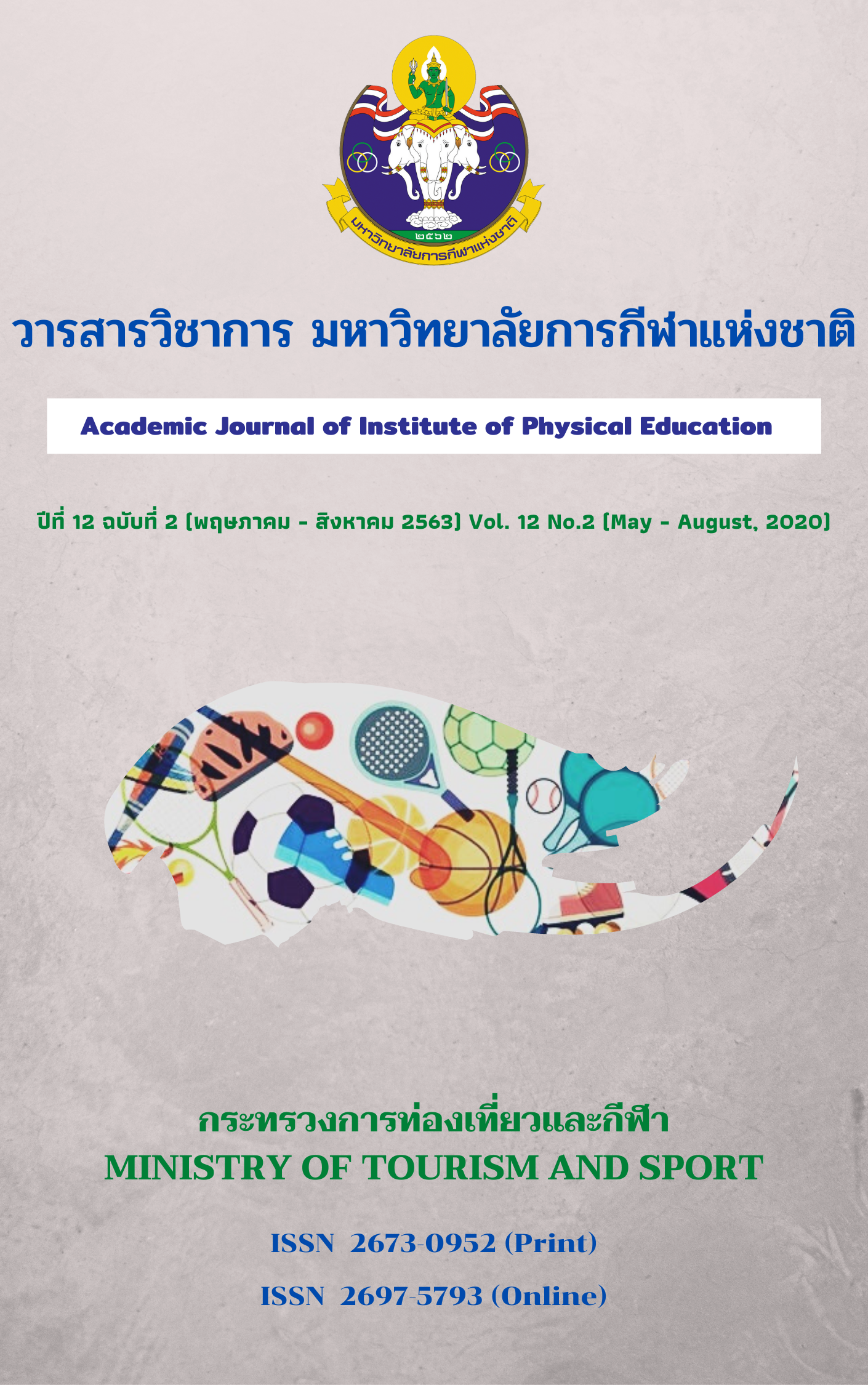EXERCISE BEHAVIORS AND BARRIERS OF STUDENTS IN SAMUTSAKORN TECHNICAL COLLEGE
Main Article Content
Abstract
The purpose of this research was to study the behaviors in and the barriers to exercise in Samutsakorn Technical College students. The samples of this study consisted of 362 students who were acquired by cluster random sampling. The instrument used to collect the data are questionnaires consisting of checklist, 5-point Likert-type scale, and open ended questions. For this research, a total IOC index of content validity was ranged at 0.73. While a whole reliability of the questionnaire determined by cronbachs alpha coefficient was 0.84. The statistics for the data analysis were frequency and percentage. Based on the analysis of the gathered data, the two findings were: 1) Samutsakorn Technical College students usually exercised alone on Sunday, 16.00 hrs. to 18.00 hrs. The main purpose of exercising was to maintain their health. The public parks were the place for exercise of the students. This was because it was close to their residence. Before exercise most of students did warm up for 5-10 minutes and cool down by stretching exercise 5–10 minutes per each time. Cardiovascular efficiency development with walking exercise was taken 30 minutes per each time. Strength exercise with weight training equipment was sometimes practiced 1–2 days a week. Flexibility exercise was regularly practiced 1–2 days a week, and duration of the exercise was less than 20 minutes and 2) there were four important barriers to exercise in Samutsakorn Technical College students, namely weather condition, lack of knowledge and understanding about exercise, no time to exercise because of a busy schedule and physical condition.
Article Details
The published article is a copyright of the Academic Journal of Thailand National Sports University. The passage appeared in each article in this academic journal is a perspective of each author which is not related to the journal. Each author is required to be responsible for all components of his/her own article. If there are any mistakes, each author must be responsible for those mistakes on his/her own.
References
Chanlak Yiammirt. (2013). A Study of exercise behaviors of Rajabhat Rambhai Barni University academic year 2011. (Master’s Thesis). Srinakharinwirot University.
Charoen Krabuanrat. (2010). Exercise for Health: Knowledge that Still Needs Understanding. Retrieved October 17, 2553, from http://hp.anamai.moph.go.th/download/document exercise%20simplyline.pdf.
Department of Physical Education. (2012). Aerobic Dance. Bangkok: Ladprao Teachers Council Press.
Division of Physical Education. (2012). Aerobic Dance. Bangkok: Ladprao Teachers Council Press.
Division of Physical Education. (1991). Guidelines for the Development of Sports Science in Thailand. Bangkok: Ladprao Teachers Council Press.
Health Systems Research Institute. (2009). The Fourth Thai People Health Survey ReportUtilizing Physical Examination Method BE. 2551-2552. (4th ed.). Nonburi: The Grafigo
System.
Kulthida Maouphet, Komkrit Chaupanit, Ponpen Lapho, & Wasitthi Thiamthaokert. (2012). Exercise behaviors of Kasetsart University Personnel, Kampangsan Campus (Research Report). Nakhonpathom: Faculty of Education and Development Sciences.
Ministry of Tourism and Sports. (2016). The Sixth National Sports Development Plan B.E. 2560-2564. Bangkok: The War Veterans Organization of Thailand Press.
Puangrat Thaweerat. (1997). Behavioral and Social research Methodology. Bangkok: Srinakharinwirot University Prasanmirt.
Raja Syed Tengku Sulaiman. (2014). Triathlon. Krabi: Institute of Physical Education Krabi Campus, Faculty of Education.
Udomsil Srisaeangnam. (2002). Running into a New Life. Bangkok: Moochaoban.
Suchat Sitthiwong. (2018). Exercise behaviors and barriers of undergraduate student in Suratthani Rajabhat University. (Master’s Thesis). Institute of Physical Education Krabi Campus.


